My high school science teacher asked me if I could make a hiking staff for one of my other high school science teachers who is retiring in September. How could anyone say “no” to that?
I started looking around for materials and coming up with ideas, and eventually decided on laminated bamboo as the primary component. Rockler sells 36″ boards and I decided I’d use 3, ripped lengthwise and assembled, lapped and epoxied with G-flex. I did a small experiment, consisting of making a little piece of the stuff, putting it in a vise, and whacking it a few times with a forging hammer. I was pretty confident, after that, that anything that ruined the staff would also ruin the science teacher, so that’s all nominal.
My first idea was to make a finial for the staff out of bronze, cast in the shape of an ehrlenmeyer flask.

That turned out to be a non-starter because I just couldn’t bear to do it. First off, that’s a lot of bronze. Secondly, the shape of the mold would be practically designed to produce a “molten bronze volcano” with that big bottom to generate steam in, and the narrow neck to constrict it all so it shoots everywhere. Perhaps I’m just being a nervous nelly, but I decided to table that decision and come up with something else later.
Meanwhile, I continued with the compositing.

I thought Real Hard(tm) about putting a carbon fiber rod down the center (I have some golf club handles) but decided that was probably unnecessary. My decisions at this time were being heavily influenced by listening to the audiobook version of Surface Detail and mentally, I was with Demeisen, in a place free from petty concerns such as “is this too over the top?” But, screw it. Bamboo is remarkably tough stuff already. When the glue was all cured, I squared the staff up on the table saw, then knocked the edges off so it’d turn more easily on the lathe.
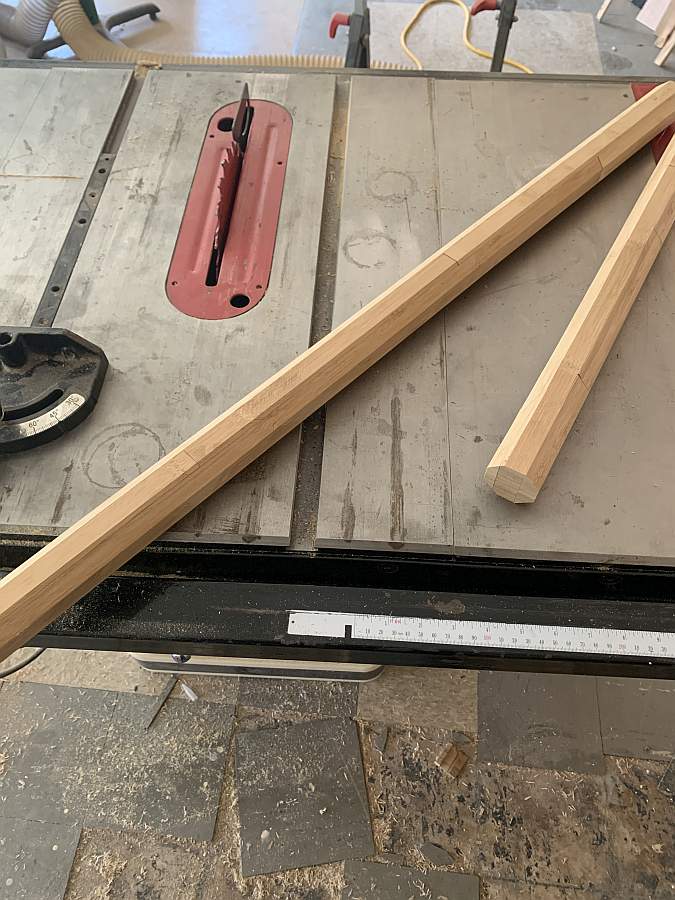
It was right about then that I realized I have a 36″ lathe and that’s not going to support a 54″ staff. Le oops. Time to quit for the day and let my subconscious noodle my way out of the problem. And, sure enough, it did: pool cue connectors!
The central post is stainless steel, and there’s a lot of room on the receptacle and post for glue to grab onto. That’ll do!

A bit of design fudgery later, and I cut the staff to cane length, then a topper piece that would take it to hiking staff length, and a separate finial so it can be assembled in two different modes. That way it looks like I planned all this.
Around now, I made my second mistake, which is that I forgot I have a gunsmith lathe (my metal lathe). Those are made with a hole straight through the arbor, so you can do things like chuck up gun barrels so there’s only a bit sticking out to thread them. Too late it dawned on me that I could have cut the whole thing using the auto-advance and the taper mode on the tailstock, and the whole project would have been done in 15 minutes or less.

Naturally, the metal lathe’s chuck would have marred the wood, but I hadn’t sanded it yet – I could have just marred away, then sanded it on the wood lathe, and been done. But, I was able to make the holes for the connectors machinist accurate. Another mistake: I should have parted off the excess end of the stock using a parting tool on the metal lathe. Then everything would have been about as perfect as humans can make it. That was not to be.
In fact, I assembled the whole thing and it looked soulless. Actually, it looked like a pool cue. The surfaces were gleaming polished and I thought “nobody would ever use this for hiking.” Impulsively, I took it over to the knifesmith’s grinder and textured it and adjusted the thickness of the handle at the top and a few other things. In the course of doing that, I made it so that the upper piece was no longer perfectly concentric. It feels better in the hand but I’m not sure if I did the right thing. This, however, raises a point of which I constantly remind myself: these things do not matter. When you’re making an artifact, the end user and audience only see and deal with the finished version, not whatever was in your head. They can’t hear your inner voice that is screaming, “no that’s not perfect!” they just look at it and go “looks good!” – they react to what they see. There have been many occasions where I am nearly ready to scrap a project, and I remember that it’s not compromising my values – it’s just that perfectionism is an enemy of getting anything done. If I want to make a perfect staff, I can do that on my own time and schedule.
For the finial, I decided to keep it simple-ish, and just sawed off a chunk of rosewood, chucked it up, center drilled it, and turned a sort of flask-y shape. Then, I did some polishing and gluing.
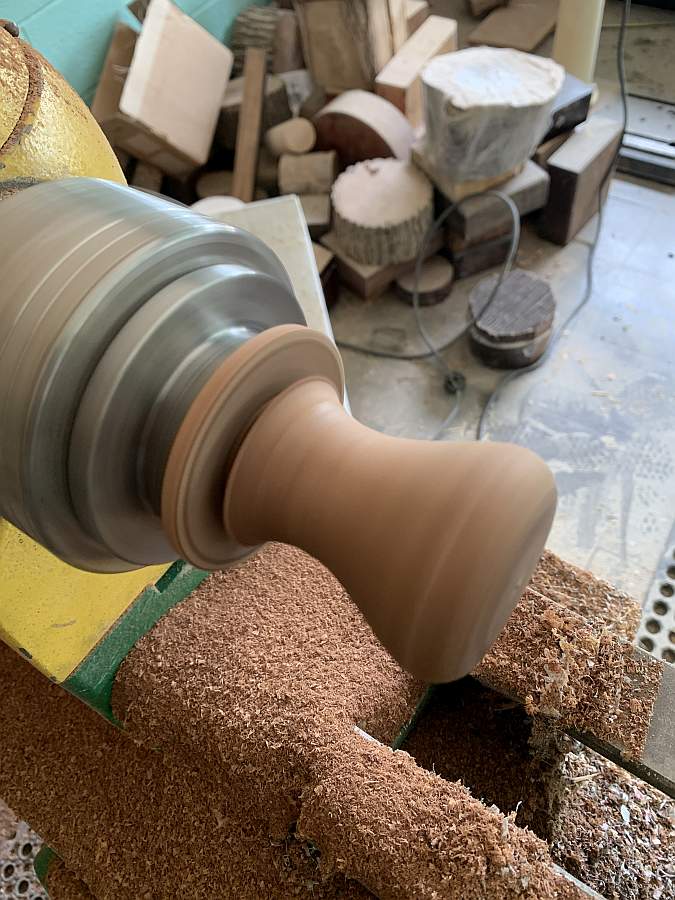
Rosewood is magic, the way it polishes right up.
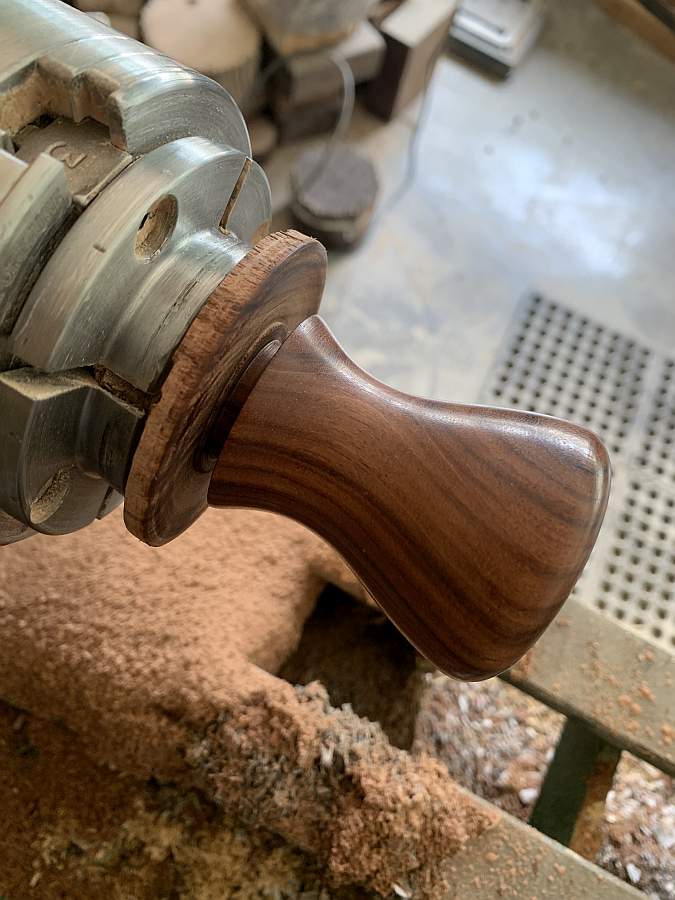
Again, I should have taken that over to the metal lathe and faced it off perfectly concentric. I didn’t. I sawed it on the bandsaw and sanded it flat. That’s when you discover the difference between “what a human thinks is dead flat” and “what a lathe thinks is dead flat.” The whole project was getting more and more analog with each step.
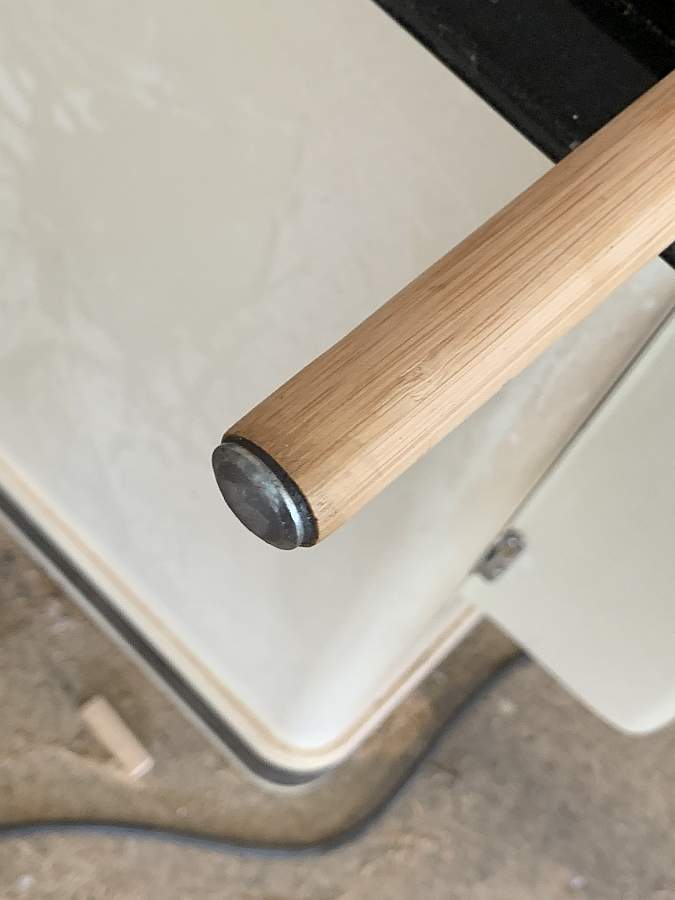
I took a 1/4-20 3″ long stainless steel carriage bolt and sunk it into the bottom of the staff, bedded down in a puddle of PC-7. If my science teacher has to fight off a bear, or a MAGA, he’ll suffer no staff failure because of me.
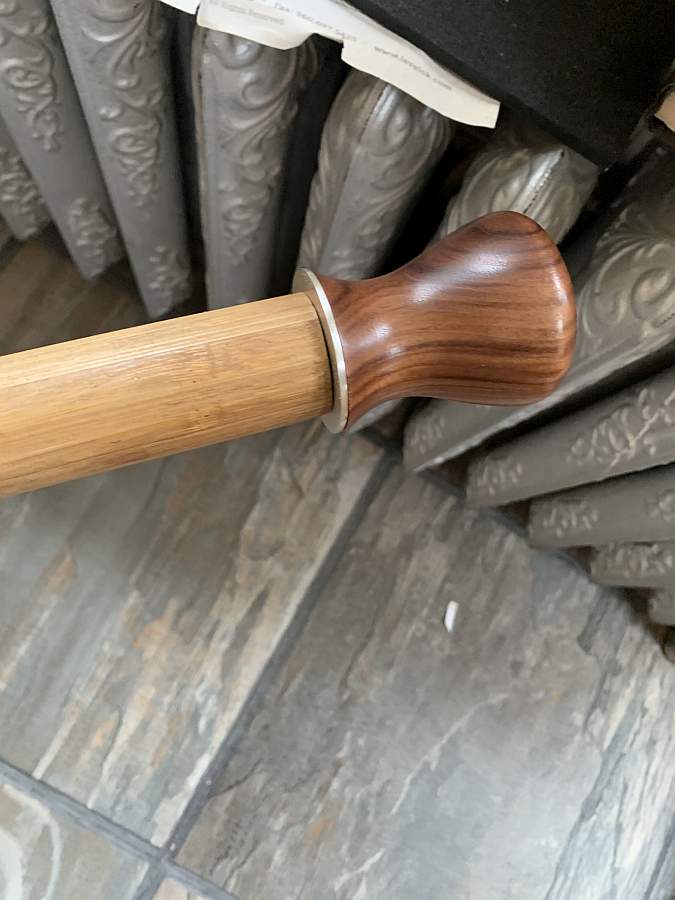
And, because of my reluctance to walk into the other room and use the metal lathe, you can see the fit isn’t perfect. In fact, the PC7 in the rosewood was air-tight, and pushed the bolt out a tiny bit so that the joint wouldn’t snug down. Well, that’s easy enough to fix: some silver, flattened down with a hammer and ground flat, drilled into a washer, and that’s… what it is. I even came up with some acceptable bullshit that, maybe if they want to, they could have the washer engraved with something suitable.
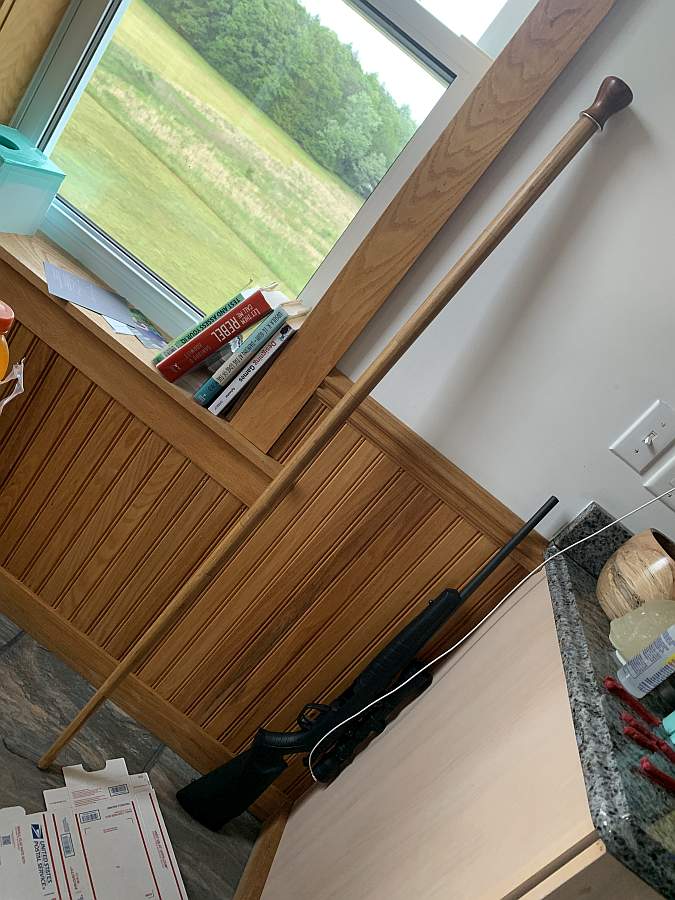
Yesterday I disassembled it, wrapped it up in polartec and tied some bows, then took it down to Baltimore and gave it to my science teacher to dispose of from there. Mission accomplished!
While I was driving down, I realized that every time I create something new, I have a bunch of problem-solving and tweaking to figure out, and by the time I’ve done a couple ${whatever} I am officially an expert. Now, if I were to make a staff, I’d rough, taper and face the whole thing on the metal lathe and it would be a single operation taking maybe 15 minutes. Then it would take me an hour to clean all the shredded wood out of the lathe. Still a huge time-saver. [By the way, professional pool cue makers use a specially set-up lathe for just that purpose, so it’s basically a “fire and forget” operation] But if I never make another hiking staff, all the skills and figuring I did will just go to waste when I stop making things. I’m still not sure if that’s motivation enough to make more staves. The techniques I figured out for this staff, however, would apply fairly well to making a spear. Hooo boy!

The staff qualifies as a fine gift, both beautiful and useful. Off-topic, but my curiosity is raised: is your rifle (scope maybe) plugged up, or is that just an optical trick of the picture?
The rifle is not plugged. It’s a .22 I use to keep woodchucks and rabbits from digging warrens up against the foundation of the house. I hate killing them (a rare event) but the crows are happy.
A beautiful project, a staff worthy of a true wizard. Or was it a science teacher? Same thing.
Marcus @2: Not sure you understood what I was asking. Not plugged, as in blocked off, but plugged as in an electrical cord seemingly attached to it. The electric (?) cord looks like it ends at the scope. Didn’t know if you had some kind of scope that needed recharging. Or maybe it is an experimental rail-gun-22. As I said, it piqued my curiosity. I have been known to ask dumb questions. Sorry for the sidetrack.
Ooh very nice
I recently had a go at a walking stick. I did the stick out of some dowel, shaped with a spoke shave and hand plane. Turned a wooden ball shape for the top and fitted it like a hammer head with a wedge.
For the cap on the bottom i soldered and hammered a little brass cup, mostly to cover the 100mm m12 bolt i weighted the bottom end with :P
pretty nifty.
I’ve got really conflicted thoughts on walking sticks, sometimes I want to put some effort into making/refining a rather nice one, but at the same time, when I’m backpacking, I tend to think of them as potentially disposable. If I’m backpacking in an area where it’s not overly impacted by people and it’s not illegal to do so, I’ll generally just find an appropriate sapling/branch and cut one down, use it for the trip, and leave it behind when I’m done.
I’ve got one I rather like, that I picked up on a biology field trip to Borneo(?), I think I paid like ~$3 for a rattan stick about ~4-1/2 ft long. worked pretty well, super light, pretty flexible, but really strong. Once I got home, I trimmed up the smashed/splintered ends, lightly sanded off the splintered fibers, put on a coat or two of tung oil, and epoxied some copper plumbing caps on the end, dipped those in plasti-dip. Not too noisy/jarring on pavement/rocks, and not terribly pretty, but it’s been with me on several trips since. I wouldn’t want to, but it’s still cheap and easy enough to make another (albeit, without the travel history/sentiments…), that I could leave it behind if needed, without too much remorse.
I’ve since had this weird desire to make a combination walking stick that I could mount a hori-hori onto for a makeshift spear. You know, for all those times you have to fight a charging boar or medieval cavalry charge in the middle of a backpacking trip. Totally rational concern…
Speaking as a dude what’s been singing in public for several years, I have a mantra which you may find comforting: The audience doesn’t notice.
Oh, I see – that’s just a basic iPhone charge cable I leave hanging there for when I’m at the kitchen table.
I think the silver escutcheon adds the perfect finishing touch to the gorgeous rosewood finial.
A walking stick that can be broken down into shorter pieces and packed into a suitcase is a great idea, so I would call that a fortuitous miscalculation rather than a mistake.
That staff needs to be more tactical. Can you embed a laser in it somehow?
@10:
This is a weapon of war
(You should of course watch the whole scene. Then the whole episode. Then the whole series.)
Reginald Selkirk@#10:
That staff needs to be more tactical. Can you embed a laser in it somehow?
It’s probably too late but it would have been possible.
A tactical staff would be a fun project. A laser and a scope mount and a tungsten carbide tip suitable for exploring the inside of someone’s skull. Ideally made of titanium with chains inside so it could be turned into a flail in the event of a zombie apocalypse.
(sigh) It’s so weird to me when I explore the possible mental landscapes of survivalists. Obviously they have drawn the wrong lessons from military history and assume everyone is going to be scrambling around in Mad Max land and magically all the guns from previous eras will stop functioning.
Tethys@#9:
A walking stick that can be broken down into shorter pieces and packed into a suitcase is a great idea, so I would call that a fortuitous miscalculation rather than a mistake.
“A fortuitous miscalculation” does sound good. I need a marketing department!
lochaber@#6:
I’ve since had this weird desire to make a combination walking stick that I could mount a hori-hori onto for a makeshift spear. You know, for all those times you have to fight a charging boar or medieval cavalry charge in the middle of a backpacking trip. Totally rational concern…
You never know! So it’s best to be prepared. That is the essence of tacticality.